Animate text or objects
You can animate the text, pictures, shapes, tables, SmartArt graphics, and other objects in your PowerPoint presentation to give them visual effects, including entrances, exits, changes in size or color, and even movement. Build a slide presentation that animates bullet points or even production credits.
Animation is a great way to focus on important points, to control the flow of information, and to increase viewer interest in your presentation. You can apply animation effects to text or objects on individual slides, to text and objects on the slide master, or to placeholders on custom slide layouts.
For related information, see Make words appear one line at a time.
Note: In PowerPoint, animations are not the same as transitions. A transition animates the way one slide changes to the next. To add a transition, see Add, change, or remove transitions between slides.
Apply an animation
-
Select the object or text on the slide that you want to animate.
An "object" in this context is any thing on a slide, such as a picture, a chart, or a text box. Sizing handles appear around an object when you select it on the slide. (For animation purposes, a paragraph within a text box is also an object, but it won't have sizing handles when you select it; instead the entire text box has sizing handles.)
-
On the Animations tab of the ribbon, click Add Animation, and pick an animation effect.
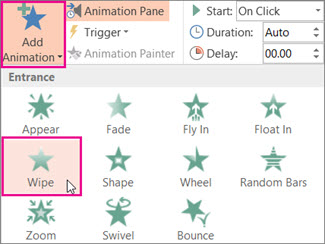
To make sure that animations play when you present your slide show, make sure that when you go to Slide show > Set Up Slide Show that the Show without animation box is cleared. If this box is checked, animations will show when you preview your slide show, but not when you present it.
To apply additional animation effects to the same object, see Apply multiple animation effects to one object, or to add a motion path, see Add a motion path animation effect.
Some entrance and exit effects (such as Flip, Drop, and Whip) and some emphasis effects (such as Brush Color and Wave) are available only for objects that contain text. If you want to apply an animation effect that isn't available for this reason, try adding a space character inside your object.
Change the speed of the animation effect
The speed of the effect is determined by the Duration setting.
-
On the slide, select the animation effect that you want to change.
-
On the Animations tab, under Timing options, in the Duration box, enter the number seconds that you want the animation effect to last.

(Maximum: 59 seconds. Minimum: .01 seconds. You can type a duration or use the up or down arrows to select a standard incremental value.)
Change how the animation effect starts
-
On the slide, select the animation effect that you want to change.
-
On the Animations tab, under Timing options, open the Start list, and choose one of the three options described below:
To start the animation effect
Select
When you click the slide
On Click
At the same time as the previous animation effect in the list. (One click starts two or more animation effects at the same time.)
With Previous
Immediately after the previous animation effect in the list finishes playing. (No additional click is required to make this animation effect start.)
After Previous

Set the time between animation effects
The Delay option determines how much time elapses before a specific animation effect begins—either after you click or after a prior animation effect concludes.
Change the order of the animation effects on a slide
To reorder a set of animations on a slide:
-
Open the Animation pane: On the Animations tab, in the Advanced Animation group, select Animation Pane.
-
In the Animation pane, select the animation effect that you want to reorder.
-
On the Animations tab of the ribbon, in the Timing group, under Reorder Animation select one of these options:

-
Select Move Earlier to move the effect up one place in the animation order.
-
Select Move Later to move the effect down one place in the animation order.
You can select an option multiple times, if necessary, to move your selected effect to the appropriate place in the animation order.
-
Remove an animation effect
When you animate an object (such as a bullet point or a picture), a small numeral appears just to the left of that object. This numeral indicates the presence of an animation effect and its place in the sequence of animations on the current slide.
To remove an animation-
Select the numeral of the animation that you want to remove.
-
Press the Delete key on your keyboard.
Animation demonstration
For a five-minute video that shows a lot of animation features, see Training: Add animations to slides.
Add animation to an object
-
Select the object that you want to animate.
An "object" in this context is any thing on a slide, such as a picture, a chart, or a text box. Sizing handles appear around an object when you select it on the slide. (For animation purposes, a paragraph within a text box is also an object, but it won't have sizing handles when you select it; instead the entire text box has sizing handles.)
-
On the Animations tab of the ribbon, in the Animation group, click the More
 button, and then select the animation effect that you want.
button, and then select the animation effect that you want.
-
If you do not see the entrance, exit, emphasis, or motion path animation affect that you want, click More Entrance Effects, More Emphasis Effects, More Exit Effects, or More Motion Paths.
-
Some entrance and exit effects (such as Flip, Drop, and Whip) and some emphasis effects (such as Brush Color and Wave) are available only for objects that contain text. If you want to apply an animation effect that isn't available for this reason, try adding a space inside your object.
-
After you have applied an animation to an object or text, the animated items are labeled on the slide with a non-printing numbered tag, displayed near the text or object. The tag appears only in Normal view when the Animations tab is selected or the Animation task pane is visible.
-
Change the speed of the animation effect
The speed of the effect is determined by the Duration setting.
-
On the slide, select the animation effect that you want to change.
-
On the Animations tab, under Timing options, in the Duration box, enter the number seconds that you want the animation effect to last.

(Maximum: 59 seconds. Minimum: .01 seconds. You can type a duration or use the up or down arrows to select a standard incremental value.)
Change how the animation effect starts
-
On the slide, select the animation effect that you want to change.
-
On the Animations tab, under Timing options, open the Start list, and choose one of the three options described below:
To start the animation effect
Select
When you click the slide
On Click
At the same time as the previous animation effect in the list. (One click starts two or more animation effects at the same time.)
With Previous
Immediately after the previous animation effect in the list finishes playing. (No additional click is required to make this animation effect start.)
After Previous

Set the time between animation effects
The Delay option determines how much time elapses before a specific animation effect begins—either after you click or after a prior animation effect concludes.
Change the order of the animation effects on a slide
To reorder a set of animations on a slide:
-
Open the Animation pane: On the Animations tab, in the Advanced Animation group, select Animation Pane.
-
In the Animation pane, select the animation effect that you want to reorder.
-
On the Animations tab of the ribbon, in the Timing group, under Reorder Animation select one of these options:

-
Select Move Earlier to move the effect up one place in the animation order.
-
Select Move Later to move the effect down one place in the animation order.
You can select an option multiple times, if necessary, to move your selected effect to the appropriate place in the animation order.
-
Remove an animation effect
When you animate an object (such as a bullet point or a picture), a small numeral appears just to the left of that object. This numeral indicates the presence of an animation effect and its place in the sequence of animations on the current slide.
To remove an animation-
Select the numeral of the animation that you want to remove.
-
Press the Delete key on your keyboard.
Apply multiple animation effects to a single object
-
Select the text or object that you want to add multiple animations.
-
On the Animations tab, in the Advanced Animation group, click Add Animation.

View a list of animations currently on the slide
You can view the list of all the animations on the slide in the Animation Pane. The Animation Pane shows important information about an animation effect, such as the type of effect, the order of multiple effects in relation to one another, the name of the object affected, and the duration of the effect.
To open the Animation task pane, on the Animations tab, in the Advanced Animation group, click Animation Pane.

1. In the task pane, numbers indicate the order in which the animation effects play. The numbers in the task pane correspond to the non-printing numbered tags that are displayed on the slide.
2. Timelines represent the duration of the effects.
3. Icons represent the type of animation effect. In this example, it is an Exit effect.
4. Select an item in the list to see the menu icon (down arrow), and then click the icon to reveal the menu.
Notes:
-
Effects appear in the Animation task pane in the order that you add them.
-
You can also view the icons that indicate the start timing of the animation effects in relation to the other events on the slide. To view the start timing icons for all animations, click the menu icon next to an animation effect and select Hide Advanced Timeline.
-
There are several types of icons that indicate the start timing of animation effects. Choices include the following:
-
Start On Click (mouse icon, shown here): The animation begins when you click the mouse.
-
Start With Previous (no icon): The animation effect starts playing at the same time as the previous effect in the list. This setting combines multiple effects at the same time.
-
Start After Previous (clock icon): The animation effect begins immediately after the previous effect in the list finishes playing.
-
Set the effect options, timing, or order for an animation
-
To set the effect options for an animation, on the Animations tab, in the Animation group, click the arrow to the right of Effect Options and click the option that you want.
-
You can specify the start, duration, or delay timing for an animation on the Animations tab.
-
To set the start timing for an animation, in the Timing group, click the arrow to the right of the Start menu and select the timing that you want.
-
To set the duration of how long the animation will run, in the Timing group, enter the number of seconds that you want in the Duration box.
-
To set a delay before the animation begins, in the Timing group, enter the number of seconds that you want in the Delay box.
-
-
To reorder an animation in the list, in theAnimation task pane, select the animation that you want to reorder, and on the Animations tab, in the Timing group, under Reorder Animation, either select Move Earlier to make the animation occur before another animation in the list or select Move Later to make the animation occur after another animation in the list.
Test your animation effect
After you add one or more animation effects, to validate that they work, do the following:
-
On the Animations tab, in the Preview group, click Preview.

Animations overview
You can use the built-in animation effects in Microsoft Office PowerPoint 2007, or you can create your own custom effects. You can apply animation effects to individual slides, to the slide master, or to custom slide layouts. For more information about slide masters and custom layouts, see Create and customize a slide master and Overview of slide layouts.
-
For step-by-step examples of the most popular animation effects for text or objects, see Use sample animations in your presentation, which will also show you how to do the following:
-
Apply entrance and exit animation effects to bullets of text
-
Apply sound effects to bullets of text
-
Apply a motion path to an object
-
Test your animation effects
-
-
For information about transitions between slides (including the different types that are available) and adding sound to slide transitions, see Add, change, or remove transitions between slides.
-
For related information, see Animate your SmartArt graphic.
Apply a built-in animation effect to text or an object
-
Select the text or object that you want to animate.
An "object" in this context is any thing on a slide, such as a picture, a chart, or a text box. Sizing handles appear around an object when you select it on the slide.
-
On the Animations tab of the ribbon, in the Animations group, select the animation effect that you want from the Animate list.
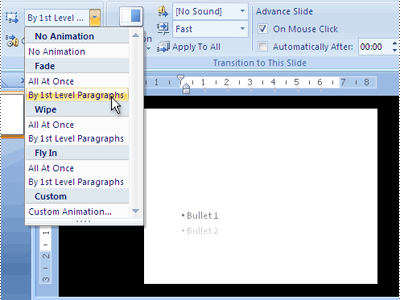
If your selected object is a text box, you'll have two options for each type of animation in the Animate list:
-
All At Once: The animation occurs for all the text at the same time.
-
By 1st Level Paragraphs: The animation occurs individually in turn for each paragraph of the text box.
-
Remove an animation effect
-
Select the text or object that you want to remove the animation from.
-
On the Animations tab, in the Animations group, select No Animation from the Animate list.
Create and apply a custom animation effect to text or objects
To gain more control over how and when effects are applied, you can create and apply a custom animation. For example, you can make text grow or shrink, spin or shimmer, and you can set an animation so that you hear the sound of applause when a picture is revealed. You can apply more than one animation, so you can make a line of text fly in with or without sound, and then make the text fly out. You can use emphasis, entrance, or exit options in addition to preset or custom motion paths.
You create custom animations in the Custom Animation task pane. The Custom Animation task pane shows important information about an animation effect, including the type of effect, the order of multiple effects in relation to each other, and a portion of the text of the effect.
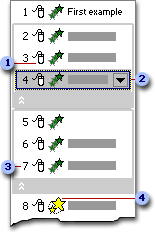
1. Icons indicate the timing of the animation effect in relation to the other events on the slide. Choices include the following:
-
Start On Click (mouse icon, shown here): The animation effect begins when you click the slide.
-
Start With Previous (no icon): The animation effect begins at the same time as the previous effect in the list starts playing (that is, one click executes two or more animation effects).
-
Start After Previous (clock icon): The animation effect begins immediately after the previous effect in the list finishes playing (that is, no additional click is required to make the next animation effect start).
2. Select an item in the list to see the menu icon (down arrow), and then click the icon to reveal the menu.
3. Numbers indicate the order in which animation effects play. Numbers also correspond to the labels associated with animated items in Normal view with the Custom Animation task pane displayed.
4. Icons represent the type of animation effect. In this example, it is an Emphasis effect.
Animated items are noted on the slide by a non-printing numbered tag. This tag corresponds to the effects in the Custom Animation list, and the tag is displayed to the side of the text or object. The tag appears only in Normal view with the Custom Animation task pane displayed.
Tip: For step-by-step examples of the most popular animation effects for text or objects, see Use sample animation effects in your presentation.
To apply a custom animation effect in Office PowerPoint 2007, do the following:
-
Select the text or object that you want to animate.
-
On the Animations tab, in the Animations group, click Custom Animation.
-
In the Custom Animation task pane, click Add Effect, and then do one or more of the following:
-
To make the text or object enter with an effect, point to Entrance, and then click an effect.
-
To add an effect, such as a spin effect, to text or an object that is already visible on the slide, point to Emphasis, and then click an effect.
-
To add an effect that makes text or an object leave the slide at some point, point to Exit, and then click an effect.
-
To add an effect that makes text or an object move in a specified pattern, point to Motion Paths, and then click a path.
-
-
To specify how the effect is applied to your text or object, right-click the custom animation effect in the Custom Animation list, and then click Effect Options on the shortcut menu.
-
Do one of the following:
-
To specify settings for text, on the Effect, Timing, and Text Animation tabs, click the options that you want to use to animate the text.
-
To specify settings for an object, on the Effect and Timing tabs, click the options that you want to use to animate the object.
-
Effects appear in the Custom Animation list in the order that you add them.
Test your animation effect
After you add one or more animation effects, to validate that they work, do the following:
-
At the bottom of the Custom Animation task pane, click Play.
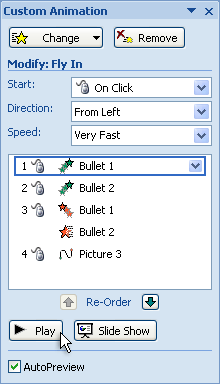
More about animating text and objects
There are four different types of animation effects:
-
Entrance effects make an object fade gradually into focus, fly onto the slide from an edge, or bounce into view.
-
Exit effects include making an object fly off of the slide, disappear from view, or spiral off of the slide.
-
Emphasis effects include making an object shrink or grow in size, change color, or spin on its center.
-
You can use Motion Paths to make an object move up or down, left or right, or in a star or circular pattern (among other effects). You also can draw your own motion path.
You can use any animation by itself, or combine multiple effects. For instance, to make a line of text fly in while it grows, apply a Fly In entrance effect and a Grow/Shrink emphasis effect to it. Click Add Animation to add effects, and use the Animation Pane to set the emphasis effect to occur With Previous.
The gallery of animation effects on the Animations tab shows only the most popular effects. Get even more possibilities by clicking Add Animation, scrolling down, and clicking More Entrance Effects, More Emphasis Effects, More Exit Effects, or More Motion Paths.
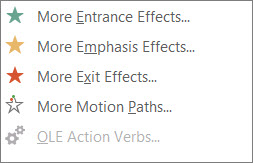
No comments:
Post a Comment